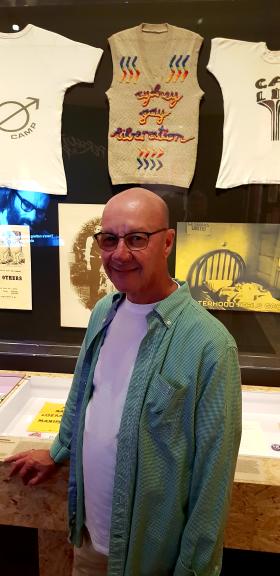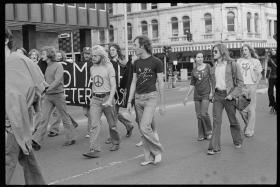It’s a zap!

Terry was an active participant in the Sydney gay liberation movement throughout the 1970s. An item in the exhibition that brings a smile to his face is a hand-lettered and mimeographed flyer printed on coarse green paper. It calls on people to ‘Zap a Newsagency’ at Central Station and demand they stock gay and lesbian publications. Although many of these publications were appearing in the 1970s, few stores would display and sell them.
First used by gay and lesbian rights activists in the US, zaps are a form of protest action that draws on visibility and spontaneity, often drawing a crowd and challenging people to think about an issue. Zaps can be confronting, making people laugh or recoil in shock; the idea is to go for maximum effect.
One of the earliest zaps Terry participated in was at David Jones’ Elizabeth Street store in central Sydney on a busy Saturday morning before Christmas. Going up and down the escalators at the centre of the store, a group of gay liberation activists made their presence known to shoppers, chanting simply, ‘Ho! Ho! Homosexuals!’ as they descended from the top floor to the ground. ‘Some people laughed,’ Terry remembers with a chuckle, ‘some cheered us on, many more were shocked and surprised, perhaps never setting eyes on a group of a dozen or so out and proud gays and lesbians before.'
Terry explains that ‘Zaps were a theatrical way of drawing attention to the issue. They were cost-effective. We were not many in number, so with a small group of people being very theatrical and out there you can maximise your attention. And because it wasn’t the conventional marching down the street and chanting, people would stop and look. Some of them would have gone-off and thought about the issues, I’m sure of that.’
He recalls that Saul Alinksy’s Rules for Radicals — a book he came across in his social work degree at university — influenced his activism. Alinsky argued that collective action for social change should be something people enjoy so that pressure can be maintained and momentum built up over time. Creativity was central to zaps. ‘We were always creative in what we did,’ says Terry. ‘That continued on into the first Mardi Gras in 1978 where we had a traditional street protest in the morning. I remember that day a group of us roller-skated at the front of the march. We mixed it up.’
The ephemera in the exhibition, like the handbill that got Terry re-living his experiences in the 1970s, was rarely intended to be preserved for the future. But as evidence of past activities, it can help researchers understand social context and fill in gaps in the historical record. The Library holds a vast collection of items like show tickets, bookmarks, store catalogues, menus, greeting and business cards, ‘how to vote’ election handbills, stickers and flyers.
‘During those days we said, “The personal was political”,’ says Terry. ‘That was the basis from which we worked and tried to live our lives. For me it’s good to be reminded, for others I hope they appreciate how far we’ve come.’
Bruce Carter
Librarian, Information & Access
The Library is interested in acquiring documents that record experiences of individuals, businesses, clubs and organisations from the LGBTQI+ community, relating to their personal lives and community activities in New South Wales, including both contemporary and historical material. Learn more.
Visit Coming Out in the 70s online exhibition.
